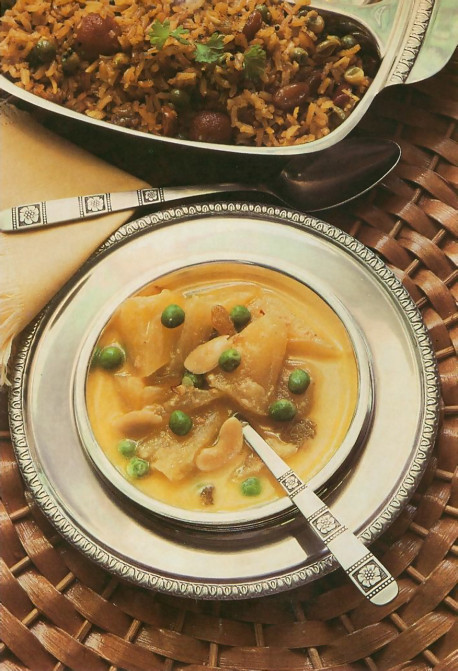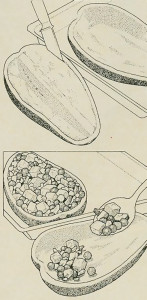Curing the Vegetarian Blues
Being vegetarian in a nonvegetarian society can be hard—
unless you know the secret of prasadam.
by Visakha-devi dasi
Glancing through a copy of Bon Appetit the other day, I couldn’t help feeling how difficult it is to be a vegetarian amidst our meat-oriented culture. On the magazine’s cover the “Chef of the Month” beamed as he carved up a well-done veal roast. The lead story featured the popular dishes of France—almost all included meat. The how-to section demonstrated cuts on a chicken. And ads depicting meat appeared throughout the magazine.
Even the classiest restaurants aren’t prepared for the vegetarian. A vegetarian friend who was obliged to go to a famous Italian restaurant for a business lunch told me of her plight. She said that when she quietly told the maitre d’ of her dietary preference, he was beset with anxiety and hurriedly left to inform the chef. Unfortunately, it was too late, and her worst fears were realized: the melon had prosciutto, the risotto had shrimp, the vegetable soup was made from chicken-stock base, and the Caesar salad had anchovies. (At one point she overheard the maitre d’ muttering to himself about the problems people cause by being different.)
Vegetarian party-goers don’t have it any easier. They invariably find themselves conversing about the protein question, the cholesterol problem, or ethics, and sometimes debating with carnivores who say vegetables are a bore. Meanwhile, the hostess is anxious lest her vegetarian guests starve before the evening is over.
Nonvegetarians feel awkward around family members who are vegetarian. When my husband and I go to his parents’ home, my mother-in-law dutifully brings out her vegetarian cookbook and, with great trepidation, launches into some vegetarian dishes, never quite confident that she or anyone else will be satisfied after a meatless meal.
Problems like these can cause all but the most staunch vegetarians to have second thoughts or even to break their resolution from time to time, unless they find ways to get around these embarrassments. My vegetarian friend at the fancy Italian restaurant, for example, pleaded indigestion. Then, while the others ate their multi-course meal, she ruminated over cream of potato soup as inconspicuously as possible. As for nonvegetarian friends and family members, you can always ask them to have a stock of fruits and nuts on hand for you. (Despite your best efforts to avoid problems, though, you’ll probably be getting fewer and fewer invitations from your nonvegetarian friends anyway.)
The best—and most radical—solution of all, however, is to eat only krsna-prasadam, food that’s been offered to Lord Krsna. That may seem too radical, but only until you taste the rewards. Prasadam is so good, you may not care to eat anything else.
Then as for restaurants, there are lots of Hare Krsna restaurants (see list on back cover). If you don’t live near one, you could visit your local Hare Krsna center. It’s open seven days a week, and every center holds a feast on Sunday.
As for parties, Krsna devotees don’t sit in the corner, mulling over potato soup. They bring prasadam from their temple and take pleasure in serving generous helpings. And after relishing prasadam, you won’t start talking about what you’re missing by not eating meat. The thought won’t even occur.
As for family gatherings, you can always go over to your folks’ house an hour or two early, prepare some vegetarian dishes, offer them to Lord Krsna, and serve them with the meal—or, better yet, as the whole meal. If you’ve practiced the recipes we print here each month, your dishes will take the cake, and you can easily guide the conversation around the glories of krsna-prasadam.
What are those glories? Well, they’re demonstrated in the life of Narada Muni, one of the greatest devotees of Lord Krsna. In his former life, Narada was the son of a maidservant and had no education. But once, while his mother was serving great devotee-sages, Narada helped her, and sometimes in the absence of his mother he would serve the great devotees himself. Narada used to eat the remnants of their food, and by so doing he became purified in heart and attracted to devotional service. As he went on eating krsna-prasadam, he gradually became as pure-hearted as the sages, always desiring to hear and chant the glories of the Lord.
Not only for Narada, but for ourselves as well, prasadam can be the beginning of our devotional service to Lord Krsna. Devotional service is the goal of religion and can be as simple and easy as tasting palatable dishes.
Although the Vedic literature doesn’t tell us exactly what dishes Narada first tasted, here are some that are fit to serve to devotee-sages—or to your family members. If you’re a vegetarian and you’ve got the blues because no one else is, offering these dishes to Krsna and then serving them to your friends is the perfect remedy.
(Recipes by Yamuna-devi dasi)
Cucumbers in Delicate Broth
(Kukri Ras)
Preparation time: 1 hour
Yield: 5 or 6 small servings
Select firm cucumbers, 6 to 7 inches long with bright green skins and round ends. If the cucumbers are filled with seeds, scoop them out and use only the firm flesh. To remove excess bitterness, sprinkle the cut cucumbers with salt and allow them to sit for about 30 minutes; then rinse and cut as directed.
2 tablespoons vegetable oil or ghee (clarified butter)
½-inch square piece of scraped ginger root, sliced into paper-thin strips
¼ to 1 teaspoon fresh hot green chilis, seeded and sliced into paper-thin strips
1 teaspoon cumin seeds pinch of asafoetida powder
14 ounces peeled cucumbers, cut into small sticks or cubes
1/8 to ¼ teaspoon cayenne or paprika
½ teaspoon turmeric powder
2 ½ cups water
1 teaspoon salt
2 tablespoons lime juice
1 tablespoon sugar or other sweetener
1/8 teaspoon garam masala, if available
1 to 2 tablespoons minced fresh coriander or parsley leaves
1. Heat the ghee or oil in a 2-quart saucepan over a medium-high flame until a haze forms over the surface. Drop in the strips of ginger and chilis and the cumin seeds, and fry until the seasonings turn a light golden brown. Sprinkle in the asafoetida powder, and then add the cucumbers, the cayenne or paprika, and the turmeric. Stir-fry for 4 to 5 minutes.
2. Add the water and salt and bring to a full boil. Reduce the flame to low, cover, and simmer slowly for 20 minutes or until the cucumbers are tender and translucent, but not mushy. Remove the pan from the flame and gently blend in the lime juice, sweetener, garam masala, and minced herbs. Cover and allow to sit for 2 or 3 minutes before offering to Krsna.
Baked Eggplant Halves Stuffed with Fried Indian Cheese and Tender Chickpeas
Preparation time: 30 minutes
Baking time: 1 hour
Yield: 2-4 servings
1 medium-size eggplant or 4 baby, round eggplants, halved lengthwise
1 teaspoon salt
¼ teaspoon cayenne or paprika powder
Ingredients for the stuffing:
¼ cup vegetable oil or ghee
8 ounces firm, fresh homemade cheese diced into 1/3-inch cubes
1 tablespoon peeled fresh ginger root, minced ½ tablespoon fresh hot green chilis, minced
½ tablespoon cumin seeds
1 teaspoon black mustard seeds
1/8 teaspoon ajwain seeds, if available
1/3 teaspoon asafoetida powder
15 to 18 fresh or dried small, sweet nim leaves
1/3 medium-size sweet green pepper, cored, seeded, and chopped coarse
3 medium-size tomatoes, chopped coarse
the pulp from the eggplant, chopped coarse
2 ½ tablespoons fresh coriander or parsley leaves, minced fine
½ tablespoon coriander powder
¾ teaspoon turmeric powder
½ cup cooked chickpeas, slightly mashed
1 teaspoon salt
½ cup plain yogurt sprinkle of paprika and parsley or coriander sprigs for garnishing
1. Using a small spoon and sharp paring knife, scoop out the eggplant centers, leaving shells 1/3-inch thick. Sprinkle the salt and cayenne or paprika inside the eggplant shells; set on absorbent paper towels to drain for about ½ hour. Preheat oven to 375 °F.
2. Heat the clarified butter in a 10- to 12-inch frying pan over a medium-high flame for 1 ½ minutes. Drop in the cheese cubes and fry for 4 to 7 minutes, gently turning them until they are crisp and golden brown on all sides. Transfer with a slotted spoon and set aside.
3. Stir in the ginger root, green chilis, cumin, black mustard, and ajwain seeds; fry until the seasoning browns slightly. Toss in the asafoetida powder and sweet nim leaves, fry for a few seconds, and immediately add the diced green pepper. Fry until the peppers glisten and wilt slightly. Add the tomatoes and eggplant pulp and fry for about 10 minutes.
4. Add the fresh herbs, coriander powder, turmeric powder, chickpeas, salt, and fried cheese cubes. Blend well. Brush the eggplant shells with ghee or oil and fill with sauteed stuffing. Place them in a shallow casserole dish, spoon the yogurt over the top of each piece, and sprinkle slightly with paprika.
5. Bake uncovered for about 1 hour or until the shells are fork tender; garnish with fresh parsley or coriander sprigs and offer to Krsna.
Pineapple and Peas in Almond Broth
(Ananas-Matter Ras)
Preparation time: 10 to 15 minutes
Cooking time: 30-35 minutes
Yield: 6 to 8 servings
An elegant, succulent blend of sweet pineapple, green peas, nuts, and seasonings. Small servings become a novelty dish on a formal dinner menu. A sweet, golden-ripe pineapple is absolutely necessary.
3 tablespoons blanched almonds, halved
3 tablespoons cashews, halved
1 teaspoon sesame seeds
1 ½ teaspoons coriander seeds
1 ½ tablespoons fresh or dried powdered coconut
1 2/3 cups water or thin coconut milk
1 teaspoon peeled, minced fresh ginger root
1 ½ teaspoons minced, seeded hot green chilis
3 tablespoons vegetable oil or ghee
½ teaspoon black mustard seeds
¼ teaspoon saffron threads
1 ¼ teaspoons salt
1 medium-size fresh pineapple, trimmed, peeled, cored, and cut into ½-inch cubes
¾ cup green peas
3 tablespoons cream
1/8 teaspoon nutmeg
½ teaspoon garam masala
1. Combine ½ of the nuts, the sesame seeds, coriander seeds, and dried coconut in an electric coffee mill and pulverize to a fine powder; transfer to a small dish. Place ¼ cup of water or coconut milk in an electric blender jar, add the minced ginger and chilis, cover, and blend on high speed until smooth. Remove the feeder cap, and by spoonfuls, feed in the pulverized powdered nut mixture. If necessary, add water to facilitate blending the mixture into a smooth, thick puree.
2. Heat the clarified butter or oil in a 3-quart saucepan over a medium flame for 1 ½ minutes. Add the remaining cashews and almonds and stir-fry until the nuts are golden brown; remove them with a slotted spoon and set aside. Raise the flame to medium high, drop in the black mustard seeds, and fry until they crackle and sputter; add the smooth, wet nut puree and a sprinkle of water and stir-fry for 1 ½ to 2 minutes. Add the remaining 1 1/3 cups of water, the saffron threads, and the salt. Cover and gently boil for about 5 minutes.
3. Add the pineapple and peas. Reduce the flame to medium-low. Cover and simmer for 20-25 minutes or until the pineapple and peas are tender. Remove the pan from the flame, stir in the cream, nutmeg powder, and garam masala; sprinkle the remaining fried nuts over the surface as a garnish, and offer to Krsna.



Leave a Reply